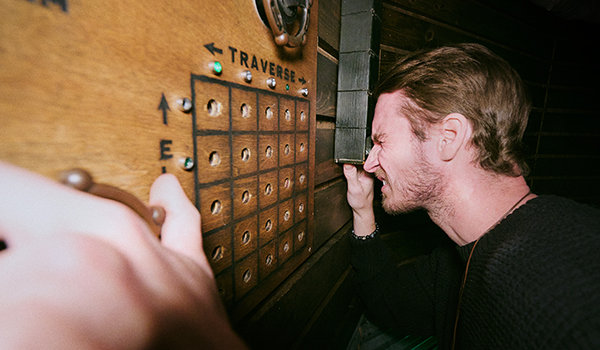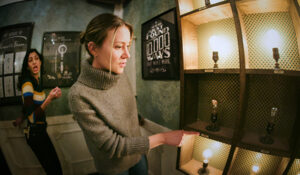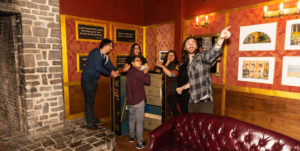As the creators of Palace Games, we have spent years building award-winning narrative adventures inside San Francisco’s historic Palace of Fine Arts. Our work has led us to a fundamental question that drives every decision we make: What elevates an escape room from a mere collection of puzzles into a compelling, story-driven experience? For us, the answer is a clear and unwavering design philosophy: the puzzles must serve the story. They are the engine of the narrative, not just obstacles in a room.
Many escape rooms follow a ‘puzzle-bunch’ approach, where the story is a thin veneer applied to a series of disconnected challenges. You might be in a pirate’s cabin, but the puzzles could just as easily fit into a spaceship or a laboratory. Our ‘narrative-first’ approach is the direct opposite. We believe every challenge, every clue, and every mechanism must be an authentic extension of the plot, a philosophy we explore in our story-driven adventures. This is the art of narrative puzzle design.
The Foundation of Immersion: Ludonarrative Harmony
To build a world that feels real, designers must achieve what is known in game design theory as ‘Ludonarrative Harmony.’ The term may sound academic, but the concept is intuitive. It refers to the seamless integration of gameplay (the ‘ludo’) and story (the ‘narrative’). As one study on the topic explains, it is the alignment of game mechanics with narrative elements to enhance player immersion [1]. When this harmony is achieved, the act of playing the game feels indistinguishable from living the story. Your actions as a player are the same actions your character would take.
To make the concept clearer, consider an analogy from filmmaking. A film’s score can be simple background music, present but not particularly impactful. Or, it can be a force that actively builds tension, reflects a character’s inner turmoil, and cues the audience into the emotional stakes of a scene. The latter is a harmonious element; the former is just noise. In escape room design, puzzles can be either background noise or a fundamental part of the narrative score. Achieving this harmony is our primary goal, as it is the key to unlocking genuine emotional investment from our players.
Diegetic vs. Non-Diegetic Puzzles: A Creator’s Guide
A critical tool for achieving ludonarrative harmony is the deliberate use of diegetic puzzles. A ‘Diegetic Puzzle’ is a challenge that exists organically within the story’s world. As explained in game design theory, diegetic elements are things that the characters in the world can see and interact with, making the experience feel more integrated and real [2]. The characters in the narrative would recognize the puzzle’s components as part of their reality. For example, in The Roosevelt Room, players are not just solving puzzles; they are acting as members of Teddy Roosevelt’s elite team, tasked with decoding military secrets and managing a crisis of national security. The maps, ciphers, and communication devices are the work itself. The puzzles are diegetic because they are the tasks a person in that situation would perform.
Conversely, a ‘Non-Diegetic Puzzle’ is a challenge that is clearly an external game mechanic. It makes no sense within the story’s context. Think of a modern digital keypad with a four-digit code suddenly appearing in a medieval dungeon or a Sudoku grid that must be solved to open a pirate’s treasure chest. These elements break the illusion, reminding players they are in a game. While they can be challenging, they pull the player out of the world we have so carefully built. Our focus on diegetic puzzles is a conscious choice to eliminate these distractions and maintain a consistent, believable world for our players to inhabit.
Narrative Gating: Using Puzzles to Propel the Story
In a story-first escape room, puzzles are not just obstacles; they are plot points. We use a technique called ‘Narrative Gating’ to achieve this. This is the practice of using puzzles to control the flow and pacing of the story, where solving a puzzle unlocks the next chapter of the narrative. As described in analyses of adventure game design, narrative devices can be appropriated to scaffold problem-solving and guide a user through a story [3].
This is fundamentally different from a simple linear puzzle path. With narrative gating, the solution itself is a moment of revelation. It does not just give you a key to the next door; it reveals a critical secret, triggers a dramatic event, or introduces a new piece of information that changes your understanding of the mission. For instance, in The Edison Room, unlocking one of the inventor’s prototypes might do more than open a drawer. It could power up a hidden phonograph that plays a message from Edison himself, revealing his true intentions and raising the stakes of your quest. This technique transforms players from puzzle-solvers into active protagonists who drive the story forward with each discovery, much like a detective in a mystery novel.
Environmental Storytelling: The Room as the Narrator
The most powerful narrator in our games is often the room itself. This is the principle of ‘Environmental Storytelling,’ a technique that uses the physical space to convey narrative and build a world. Much like theatrical set design, the environment is not a passive container for the game; it is an active participant in the story [4]. Every prop, texture, lighting choice, and sound effect is a deliberate narrative beat designed to immerse the player in the world.
At Palace Games, we have a unique advantage in this regard. Our home within the historic Palace of Fine Arts is not just a venue; its real history is woven into the fabric of our games. This provides a layer of authenticity and grandeur that a typical storefront location simply cannot replicate. The immersion begins before you even enter the room, as the entire process, from booking to your arrival, is designed to set the stage for the adventure to come. As our arrival information suggests, the experience starts the moment you step onto the grounds. The environment tells a story of its own, enriching the narrative you are about to enter.
Conclusion: The Art of the Unforgettable Adventure
Ultimately, we believe the most memorable escape rooms are a form of interactive art. They blend the mechanics of game design with the immersion of theater, creating a space where players become the protagonists of their own adventure. This concept of ‘audience agency,’ where participants can actively influence the narrative, is a powerful force in modern entertainment, from video games to immersive theatre [5]. By placing story at the heart of every puzzle, we give our players the agency to not just solve a game, but to live a story.
Our commitment at Palace Games is to continue pushing the boundaries of this art form. We strive to create experiences that are more than just a fun hour of puzzles; they are unforgettable story-driven activities that challenge the mind and stir the imagination. The future of interactive entertainment lies in its power to tell stories in new and deeply personal ways, and we are proud to be at the forefront of that adventure.



